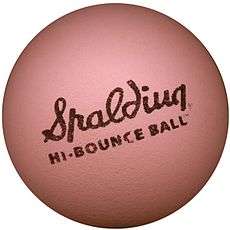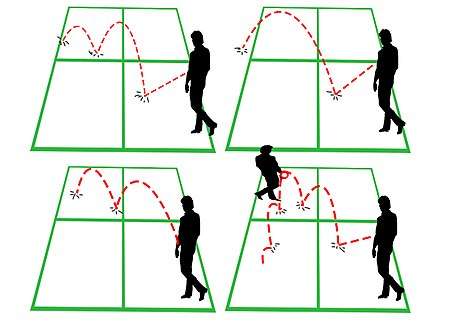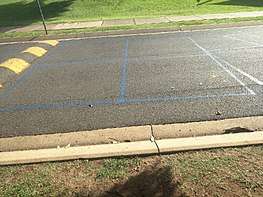Handball (school)
| Players | 2 minimum |
|---|---|
| Skill(s) required |
Manual dexterity Strategy Social skills Hand-eye coordination Endurance Strength Determination |
School students in Australia, New Zealand and Fiji often play a style of handball (Also known as four square or - square, with the number in the latter determined by the number of players) that is different from nearly all other types of handball. The game is played at recess, lunch or before and after school. It can also be played at home or anywhere that has a hard surface and at least one line. It has quick set-up time and simple rules, contributing to its popularity.

Unlike most types of handball, this version does not incorporate a wall, instead relying on lines on the ground. A typical handball court is a square split into four, usually by painted lines or expansion joints, with the highest and most prestigious position on the court being Ace, followed by King, Queen, then Dunce. The most radical change from American handball is that players must bounce the ball (usually a tennis ball or a high bounce ball) in their own square first, until it is allowed to bounce into another player's square. Each player, if the ball bounces within their square, must then hit the ball with their hand, have it bounce within their own square once, and then an opponent's square. Failure to do so results in the player being relegated to the lowest position on the court, or the last of the players waiting to enter the court. Due to the social nature of handball at school and the simplicity of playing, many variations to the rules can occur. For example, one group may play in a square of four while the next school over, the game is played in a straight line of six squares, radically altering the game. In addition, some variations of the game allow for the head or feet to be used to return the ball. As a result, this article only covers the most common rules and is not representative of every variation. In other words, the rules may vary between schools, but basic rules usually remain the same.
Rules
Basic rules
- A game must have at least two players.
- The person in the leading square, 'serves' the ball, bouncing once within their square before entering an opponent's square.
- Once the serve is complete, the receiver must hit the ball to another player.
- The ball must be hit so that it bounces in the player's own square on the first bounce, and into another player's on the second bounce.
- If the first bounce lands on the line and is not a 'full' or a 'double', it is known as 'line'. When 'line' is called the point is replayed.
- If the second bounce of the ball lands on a line between their and another player's square, the ball is deemed to have bounced in the other player's square, thus play continues.
- If an outside object interferes with the play, the point will be replayed.
- When a player is 'out', they must proceed to the lowest square, or to the end of the line of players waiting to enter the court. Players on the court who were of a lower position each move up a square.
The player is 'out' when they have committed any of the following:
- Full: when the ball lands in another player's square on the first bounce, the player has 'fulled' or has hit a 'full'.
- Out: when the first or second bounce lands outside of the court, the last person who touched the ball is out.
- Double: when the ball bounces twice in a person's square, the person who is in that square is out. Usually known as 'double' or 'double bounce'.
- Double touch: when the ball is touched twice in a row by the same person.
- Grab: when the ball is held or scooped instead of a clean hit.
- Interference: if a player interferes with another player, they are out.
- Foul: when the ball bounces in players square and is not returned to another players square via a hit (the ball then goes out or into another players square).

Variations
Due to the rules of handball varying from school to school, the following variations have developed:
Lines: depending on the location or age-group, the definition of a 'line' changes and their role in the game also changes. Generally, in younger age groups, if the ball lands on any line separating two opponents on any bounce, it is treated as if it were a line and the point 'replayed'. However, depending on school or institution, lines can be treated as if they are a part of an opponent's square, thus the game will always continue if the ball hits the line. In instances where the ball may fall on a line separating two squares on the full, the square that the majority of the ball bounces in is consider to be where the ball landed. On the opposite end of the spectrum, some games will deem a ball to be 'out' if it hits any line that does not border another square.
Outs: in some locations, due to surrounding objects, a handball court may 'extend' onto walls, the roof or external objects such as poles, lockers and windows. In this variation, commonly known as 'rebounds', the ball can bounce off, hit or roll along any other surface near the court as long as it is returned to the court. In this game, the ball is only considered to bounce when it hits the floor of a player's square.
Grab: in many establishments, the definition of a 'grab' is hotly debated. In some instances, a grab is considered to be any motion when the ball is held. In others, a grab is outlawed however a 'cradle', a low bouncing shot where the ball is balanced in the palm, is allowed. In some games, especially for lower aged groups, grabbing the ball may be allowed.
Interference: in some versions of the game, interference will resulting in the point being replayed. In other versions a player may committee a 'ghost' without repercussions, where a play attempts to put another player off by moving any part of their body near the ball as the player attempts to hit it.
Readiness of the players: in some games, players must be fully ready before the player in the top square can serve. In other styles, the player must only be in the square to be considered 'ready'. Finally, in some versions a player may serve at any time, as long as they call 'ever-ready' as a warning to players to prepare to commence the point.
Serving: In most games, as serve is conducted by the player it the highest square throwing the ball into the other square. In other variations, the player must hit the ball out of there hand to make a serve. It is common in games that a player call 'decent' on a serve that not easy to hit, and the point is retaken.
Cherries: in younger age groups, a game may develop where 'fulls' are allowed, to make play easier.
Playing on: In the majority of games the 'first-fault' style is used, where - when a player gets out and play continues or multiple outs occur - the play is stopped and the first person to get out is deemed to be out. In other games, 'two-play-on-play' is used, where the point may continue if two hits by two other players occur.
The court
Even though each part of the court is referred to as a 'square', a square can be any shape or size. Its edges or 'lines' can be marked with any material, including: paint, expansion joints, cracks, chalk or points where the square meets an object such as a wall or locker. Commonly, the court is either a bitumen or concrete surface. Depending on the school, the squares will either be labelled Ace, King, Queen and Dunce or King, Queen, Jack and Dunce.[1]

In popular culture
In popular culture, handball has grown popularity in the current 'meme' culture. In Australia, former prime minister Kevin Rudd released a video in March, 2013 of him playing handball at Brisbane State High School.[2] This triggered a growth of popularity in handball, and lead to him being ingrained into 'handball meme' culture. In late November, 2017, Kevin Rudd played handball with students in a school in Brisbane, and the accompanying video - claiming he is the "king of handball' - reached 40,000 views on Facebook.[3]
Handball is also the main theme of the children's television series, Handball Heroes, which aired on ABC Me.[4]
References
- ↑ "Four Square Handball Rules" (PDF). Moore Teaching Tips.
- ↑ Kevin Rudd (2013-03-10), Playing handball at Brisbane State High School, retrieved 2017-10-31
- ↑ "Handball Memes". www.facebook.com. Retrieved 2017-10-31.
- ↑ "Handball Heroes". ABC Television. Retrieved 2017-10-31.